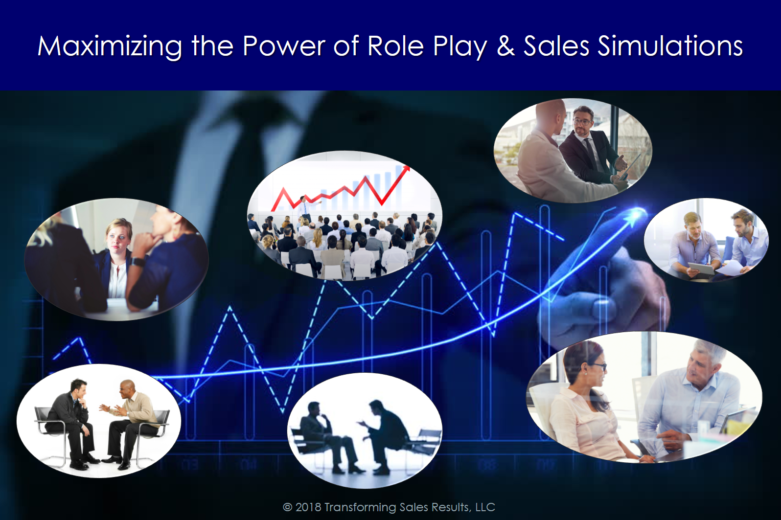Maximizing the Power of Role Play and Sales Simulations

It’s unfortunate that role play has a low level of acceptance in many sales organizations. Done well, it’s one of the very best ways to train, coach, and improve skill levels. In this post, I’m not going to attempt to convince you that role play is an outstanding learning or performance improvement tool. For that, see this post on why it’s time to get serious about purposeful practice in the sales profession.
Instead, today, I’ll share role play and simulation types and considerations for incorporating role play, simulations, and deliberate practice into your onboarding, ongoing development, sales methodology implementations or certification programs. Keep in mind that with the sales enablement technology on the market today, many of these options can be conducted both virtually and in-person.
One-on-One, Paired, or A/B Role Play
One-on-One or Paired Role Play, also referred to as A/B Role Play, can be done with an enablement specialist, sales trainer, peer, fellow learner, manager, leader, or other sales coach. It’s an excellent method for demonstrations and for conducting Understanding Checks during field training or coaching (having the rep role play something back to ensure they understood and can do it). It’s good for initial practice of a skill. It’s less optimal for providing feedback, unless the person playing the customer role can take notes or record the role play. It’s often used in “on the fly” role play between a rep and their sales manager, and does excel for that purpose. A One-on-One can also be done on the phone (voice-to-voice or video app), via webcam/video conference, or through a virtual coaching platform.
Triad Role Play
This is a common role play used in sales training courses, with three roles: Salesperson, Customer, and Observer/Coach. Usually, each person gets to play each role (three role plays per Triad). Sometimes, due to time limitations, only one student gets to play the Sales role. I respect the time crunch, but while the others do learn through observation, I’d stress that this is less than optimal. If the words aren’t coming out of the learner’s mouth, it’s not the same type of learning experience.
Often, all three participants are students in the course, which can reduce the effectiveness based on the skill levels of the students and the qualification to play each role seriously (you can lose realism with the Customer role and lose feedback effectiveness with the Observer/Coach role).
You can elevate the effectiveness of Triad Role Plays (and all the others) by having other employees, executives, coaches, consultants, or actors play the Customer role (instead of a fellow trainee) and by using a sales trainer, sales manager, or professional sales coach in the Observer/Coach role. Consider this advice ubiquitous, for all the below types of role play.
Despite some of the drawbacks, which can be overcome, this is a staple of classroom role play, skill building, and skill validation, and should be maximized.
Fishbowl Role Play
A Fishbowl is when a role play occurs in front of a group of people, usually in a classroom. It can be done in virtual instructor-led training (vILT) with or without video, or in a classroom ILT setting. Because they are single-threaded (one person at a time plays the Sales role in front of everyone else), Fishbowls take longer, but they are a great vehicle for getting a wide range of feedback from multiple observers. To be valuable, a professional trainer or coach should lead the debrief and ensure adherence to effective feedback guidelines. (See the section below, titled “Debrief Properly.“)
People tend to feel more pressure or performance anxiety in Fishbowls, which may need to be managed by the instructor. While I have empathy and compassion for the learners in this situation, professional B2B enterprise-level salespeople must perform well in rooms of executive buyers. Like Toastmasters, role plays – and especially Fishbowls – provide an opportunity to practice, possibly even fail and learn, in what should be a safe, supportive environment (so be sure to create one – psychological safety is key). They also offer a good vehicle for skill certification (or if you are also doing field observation for certification, as part of the pathway toward certification).
Lastly, Fishbowls can be used prior to break-out session role plays such as Triads, to provide an example for everyone else. Doing this sort of demo (whether done by the instructor or a volunteer student) can avoid a lot of challenges that are hard to reign in once Triads have started, often in various break-out locations.
Round-Robin Role Play
A Round-Robin Role Play is a form of the Fishbowl where the Sales role rotates among participants. Often the instructor or sales manager plays the Customer role, for consistency. Everyone can be an Observe/Coach, like a Fishbowl, or you can assign a specific person, or leave the coaching in this case to the instructor. Robin-Robins tend to have a “game” feel and are generally used to offer a lighter, more fun version of practice that forces participants to stay focused and think on their feet. The order of the Salesperson role can be pre-determined (moves clockwise, for example), or can be called out on-the-spot by the instructor or last-person to play the Sales role, “tagging” the next person.
Round-Robin Role Plays are generally high energy activities but are not a good vehicle for skill validation or certification.
Single Skill Practice
As the name implies, a Single Skill Practice Role Play is an opportunity to practice a single skill, such as “make an empathy statement” or “deliver a prospecting approach.” They are often done in round robins or pairs. In the empathy statement example, the Sales role would be presented with a scenario and statement from a customer, after which they would be expected to make an empathy statement, following the guidelines for such that were taught in the course (offering a job aid to the Observer to monitor and ensure compliance).
Doing a series of Single Skill Practices (as the skills are taught) is an effective technique for later teeing up a larger role play. For example, if “Make an empathy statement” is step 1 of a six-step process you teach to resolve client concerns, you could have learners practice each step in a Single Skill Practice to get comfortable with each and receive feedback, then do a larger Paired, Triad, or Fishbowl Role Play to practice the entire process.
Case Study/Scenario Role Play
These are often used in Triads, but may be used in any role play. This technique is designed to create as real a simulation as possible for the role play practice. After Single Skill Practices or other forms of learning, the Scenario Role Play is often used to “pull it all together” and test the rep’s understanding, judgment, and skill use in a realistic scenario. Cases or scenarios are often built from real customer situations that were culled from interviews with subject matter experts during the training design and development.
Since the goal here is realism and creating a practice environment in a simulated setting, the advice mentioned earlier applies even more here… you can elevate the effectiveness by having other employees (not the other students in a class), executives, coaches, consultants, or actors play the Customer role and by using a sales trainer, sales manager, or professional sales coach in the Observer/Coach role.
These role plays can double as learning sessions or skill validations or certifications.
For learning purposes, the goal is to:
- Practice judgment and skill use in a realistic business setting (synchronous dialogue vs. asynchronous messaging practice)
- Receive feedback from experts (in the content and in delivering behavioral feedback)
And then whenever possible, for increased effectiveness, to:
- Rework the role play to incorporate the feedback and learning
- Practice again to do it even better
For skill validation, pre-certification (if you are also doing field certification) or final certification, using Scenario Role Play is one of the strongest options, especially when incorporating the best practices mentioned above.
Process Simulations
A Process Simulation is an advanced form of a Case Study/Scenario Role Play that spans beyond one interaction to include a series of key prospect/client interactions, over time. An example might include an extended Scenario Role Play with simulated but very realistic interactions with more than one buyer, over multiple meetings.
Here’s one possible example of how to architect a process simulation:
- Assignment and review of scenario/business situation, account, and contact information.
- Completion, review, and sign-off on Sales Call Planning form (perhaps embedded in your CRM).
- Review and sign-off of omnichannel prospecting approach and/or Account-Based Selling (ABS) approach.
- Prospecting call role play with Buyer 1 to set appointment.
- Discovery call role play, part 1, with Buyers 1 and 2, including some Opportunity Qualification.
- Discovery call role play, part 2, with Buyers 1-3, including the remaining Opportunity Qualification.
- Demo or Solution Presentation role play with Buyers 1-3, including process for Resolving Concerns
- Negotiation role play with Buyer 3, the Economic Buyer.
- The Final Commitment meeting role play.
While this sounds like a lot, there are companies that are doing Process Simulations and I have used them in the past. It’s often done in stages, over the course of the sales onboarding process, as the various process stages are taught, sometimes with a capstone certification at the end. This is the value in developing training by business process and performance milestones, as it prepares the rep as much as possible in a training environment for what they will be facing in the real world with your buyers and accounts. I’ve also used them as the foundation for a day-long skills certification program, with executives and actors playing the client role and the sessions being recorded for review, coaching, and certification.
Other Advice
Debrief Properly
1. Start with the Sales role first (self-feedback). Start with their positive review, then move to constructive.*
2. Do the Customer role second for perspective on what it felt like on the receiving end. Again, positive first, then constructive
3. Get feedback from the Observer role (the individual or fishbowl gallery) next. Positive, then constructive.
4. The Sales Manager should weigh in last and flip the order: Do constructive first, then positive (to end on encouragement).
* Note: People will naturally start to critique themselves first. Redirect that and shape them into the right pattern and habits.
This cultivates a growth mindset and most importantly, creates a positive, supportive environment of psychological safety and learning.
Stopping and restarting
Should you stop a role play in motion (call a “time-out”) to provide feedback or redirect the learners? This is always a judgment call, but I typically base my decision on:
- The objectives for the role play
- The length of the role play (re-running a one-minute Single-Skill Practice is a lot different than re-running a 15-minute Scenario-Based Triad)
- How far off-track the Sales or Customer roles have veered
Behaviors can be shaped over time, so it may depend on whether it’s the very first skill practice or a later rehearsal. Since the purpose of practice is to hone skills, and skills get honed when practiced using the frameworks and models taught in the class (or your chosen sales methodology), it won’t help to just let the rep do what they normally do versus using best practices. It also won’t help if the Customer role is completely unrealistic. Those are the best times to pause and redirect, in my opinion. Without veering off into a debate on perfectionism (I’m not advocating for it), keep the old adage in mind that “Perfect practice makes perfect.”
It’s not always necessary to restart the role play from the beginning. In fact, I wouldn’t unless completely necessary. I would pause it by calling a time-out, coach and redirect, and restart where necessary. If that means a complete restart, so be it, but it usually isn’t required. Just pick-up slightly before where you interrupted.
Talking through the role play vs. playing the role
Over the years, I’ve seen this more than I ever imagined I would. Some reps seem to have a mental block about putting themselves into the role and speaking with their Customer role partner as if they were in a real customer discussion. Their go-to approach is to tell you what they would say and talk-through the role play. It’s not easy sometimes, but if you want to help them, it’s important to coach and redirect until they are playing the role. It’s okay to talk through the strategy and how you plan to do something, but that is not the same as actually doing it.
_________________________________
As usual, this is what I think. More importantly… What do YOU think? I’d enjoy hearing your thoughts in the comments and your experiences with making role plays and simulations work.
Thanks for reading, be safe out there, and by all means… let’s continue to elevate our sales profession.
Mike
Get connected / follow my content:
- This blog: https://www.mikekunkle.com/blog
- My posts on the SPARXiQ Blog: https://sparxiq.com/author/mikekunkle
- My LinkedIn articles: http://bit.ly/MikeKunkleLIPublisher
- My Sales Effectiveness Straight Talk recordings: https://bit.ly/MikeKunkle-OnDemand
- My LinkedIn profile: https://www.linkedin.com/in/mikekunkle
- My Twitter profile: https://twitter.com/mike_kunkle


